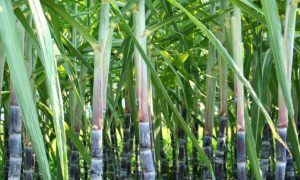M’singh farmers make profit from red sugar

In Fulbaria Upazila, Mymensingh, the demand for handmade red sugar, Lal Chini, is rising, valued at Tk 100 crore this season. Farmers craft this traditional sugar from December to March, despite challenges from white sugar competition and lack of government support. Experts highlight its rich nutritional benefits. Increased sugarcane cultivation is encouraged, with a proposal for GI product recognition. Fulbaria’s red sugar continues to reflect the area’s historical significance and cultural heritage.
The demand for handmade red sugar, locally known as Lal Chini, a cash crop for hundreds of farmers, mostly small and marginal from different villages in Fulbaria Upazila of Mymensingh, is on the rise marking a significant trend in local agricultural entrepreneurship.
The sugar, which is estimated to be worth Tk 100 crore this season, is highly sought after due to its distinct flavour and production process.
Red sugar, a product with ancient origins, continues to be produced in the upazila, serving as a testament to the area’s rich cultural heritage.
According to experts in archaeology, anthropology, and history, the oldest land in the country is made up of red soil, and the majority of the soil in Fulbaria is an extension of the red soil found in the Madhupur Bhawal region. Fulbaria, therefore, holds significant historical importance.
Fulbaria was once a prosperous region that was well-known for its sugarcane, sugar, and molasses production. Sugarcane cultivation was once widespread in villages such as Bakta, Kaladah, Radhakanai, Enayetpur, and Naogaon, with the sugarcane being sent to sugar mills. However, the price of red sugar fell due to competition from white sugar, resulting in a decline in sugarcane cultivation.
However, the tradition persists. From Bangla month mid-Poush to Chaitra, a flurry of activity fills the air as farmers of the villages harvest sugarcane and craft the famous red sugar in traditional ‘Jaal ghars’ [rooms in which sugarcane juices are boiled for granulation].
The sweet aroma from the cauldrons of a Jaal Ghar wafts through the air, letting the sweetness of Mymnesingh run amock. However, Fulbaria’s unique red sugar, once thriving across five unions’ red soil, faces decline. Lower prices and lack of government support push farmers towards more profitable crops.
However, upon talking to several farmers, this correspondent learned that the market for this special sugar is much higher this year compared to the previous year. At the beginning of the season, the wholesale price of red sugar ranges from Tk 6,000- 6,500 per maund.
Following sugarcane planting in mid-Boishakh, farmers cover the well-worked fields with straws to retain moisture and suppress weeds. Days later, sprouts emerge, transforming the area into a vibrant green field. This is when the meticulous maintenance routine begins. A combination of organic and chemical fertilisers, applied as needed, nourishes the young plants as they mature into towering sugarcane stalks.
Before the sugarcanes are crushed, farmers build a Jaal Ghar to granulate red sugar. To make the sugar, they use a three-shaft iron pressure machine, either operated with a shallow machine or by connecting an electric motor. However, some still operate the pressure machine using traditional methods, like pulling the rotors using oxen or buffaloes to extract the sugarcane juices.
Large cauldrons filled with raw sugarcane juice are heated on clay stoves for about half an hour to make the traditional red sugar. After the juice has thickened, it is then taken down from the heat and continuously stirred with a wooden stick. The caramelised liquid is kneaded until it granulates. If the quality of the harvested sugarcane is poor, it becomes lumpy instead of grainy. Whether grainy or lumpy, the final product is known as the traditional red sugar of Fulbaria.
The farmers then dry the caramel and sell it to the market vendors. The sugarcane stalks in one Katha (6.612 decimal) produce about 45 to 50 tinned containers of juice, each holding 15 to 16 kilogrammes of raw juice. Approximately four to five kilogrammes of granulated red sugar are obtained from each container.
Mubarak Ali Master, a sugarcane farmer of Kaladah village, said, “Fulbaria’s red sugar is appreciated all over the country. Mymensingh has been producing it solely for 250 to 300 years in Bangladesh. However, it became known as ‘Laal Chini’ or red sugar only after the refined finely-granulated white sugar of the sugar mills came to the market. Snacks made with this red sugar taste miles apart from the ones made with white sugar.
Palashtoli villagers Sattar and Saiful Islam say they have cultivated sugarcane on 20 Kathas of land each. However, they do not get much cooperation or advice from the Department of Agricultural Extension regarding the cultivation. Sugarcane is mostly attacked by pests locally called ‘Menda’. These pests make holes in the stalks and make them their home, which then kills the sugarcanes.
They opined that increased cultivation would be possible if the government provided training on sugarcane cultivation and promoted improved varietals.
Fulbaria Upazila Agriculture Officer Noor Mohammad said, “In addition to old sugarcane varieties, Ishwardi-41 is yielding well in Fulbaria. We regularly inform farmers of sugarcane diseases and pests and promote new and improved varieties. We estimate that Tk 100 crore worth of red sugar will be sold this year.”
Mymensingh DAE Deputy Director Nazrin Akhtar Banu said, “A plan is underway with the relevant authorities to get GI product recognition for the 300-year-old traditional red sugar. Additionally, the Agriculture Office is working consistently at the field level to encourage farmers to cultivate sugarcane.”
Experts have advised consuming red sugar to avoid health risks. Red sugar is unrefined and contains glucose, calcium, potassium, magnesium, iron, manganese, beneficial amino acids, zinc, thiamine, riboflavin, folic acid, antioxidants and other necessary minerals.
Source Link : https://businesspostbd.com/national/msingh-farmers-make-profit-from-red-sugar














